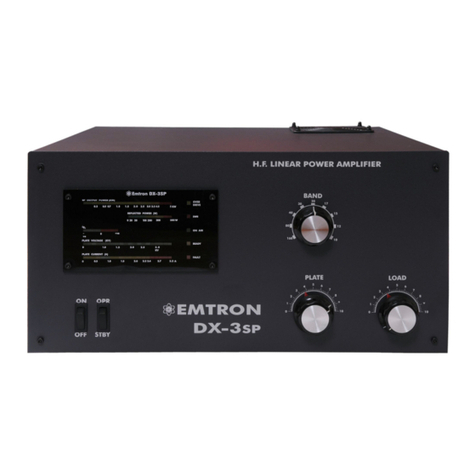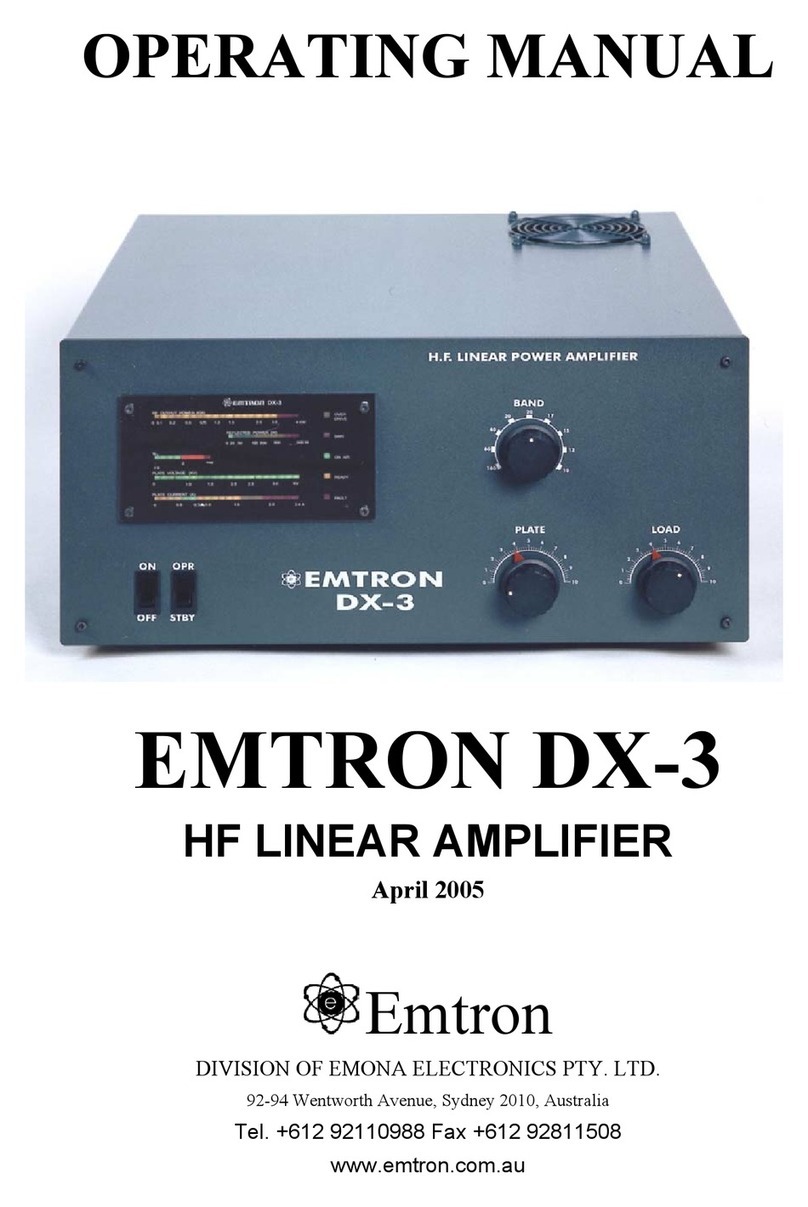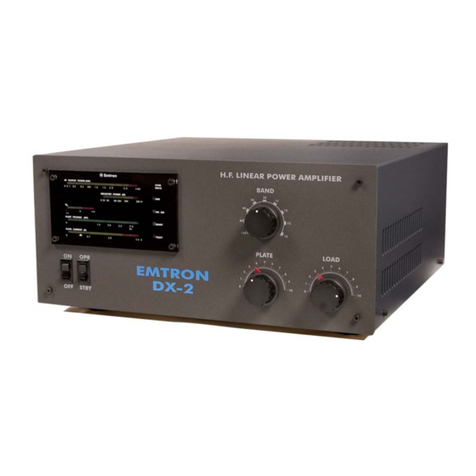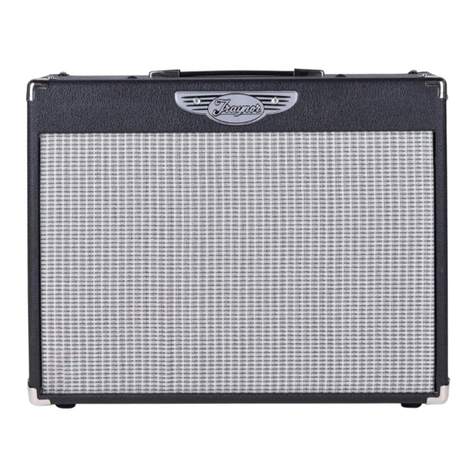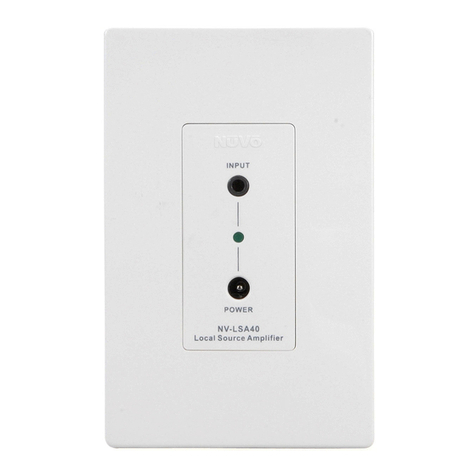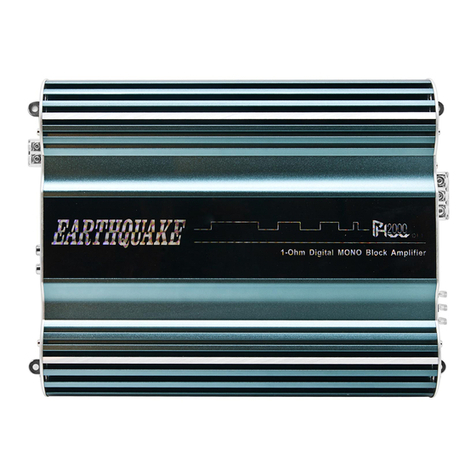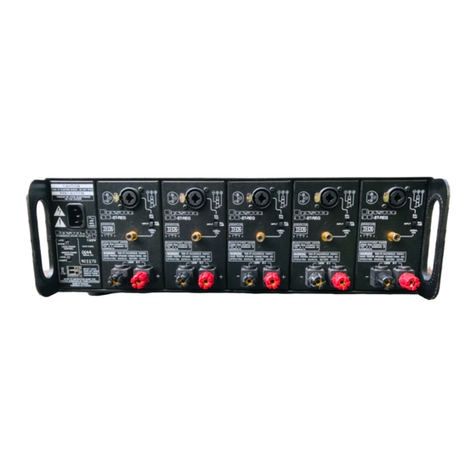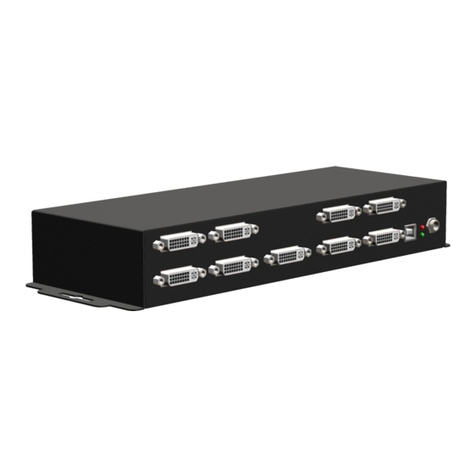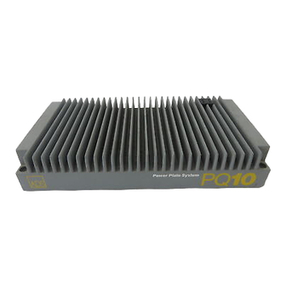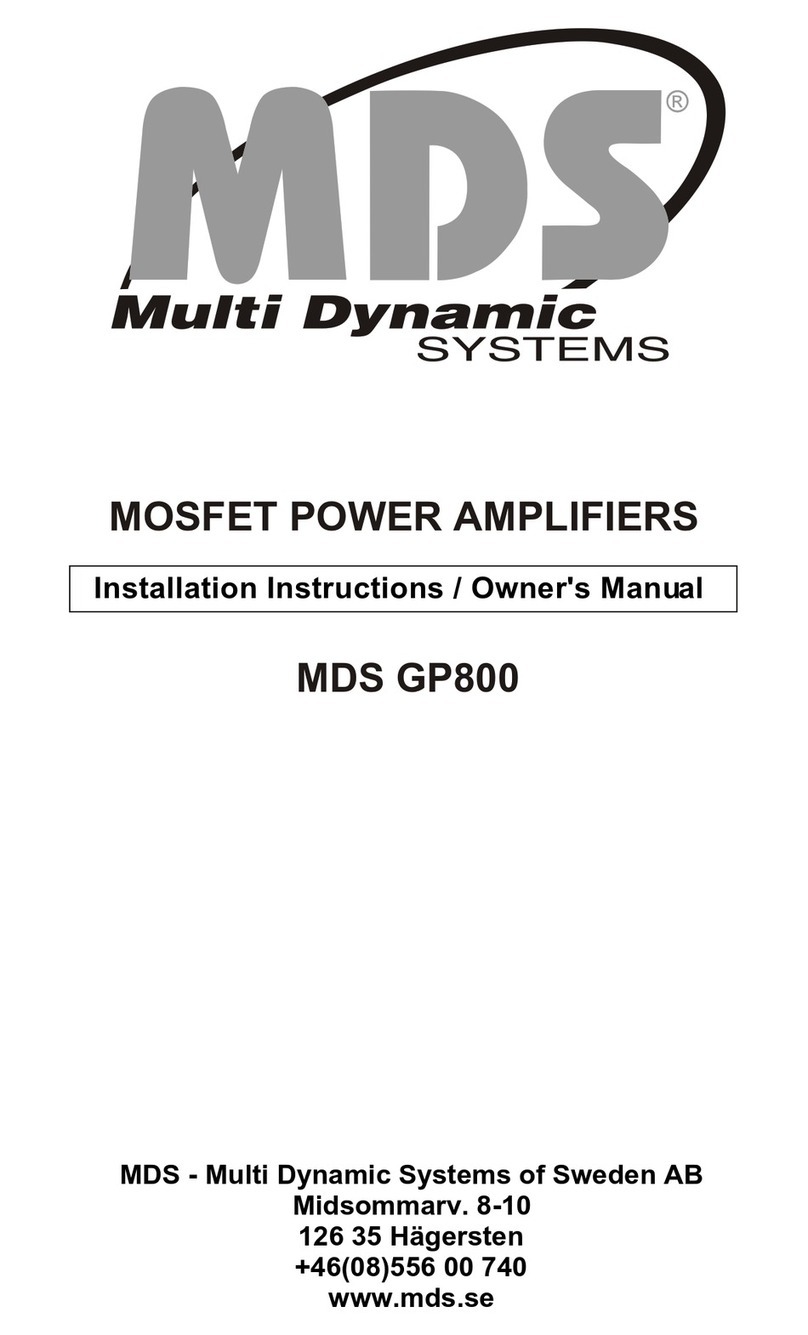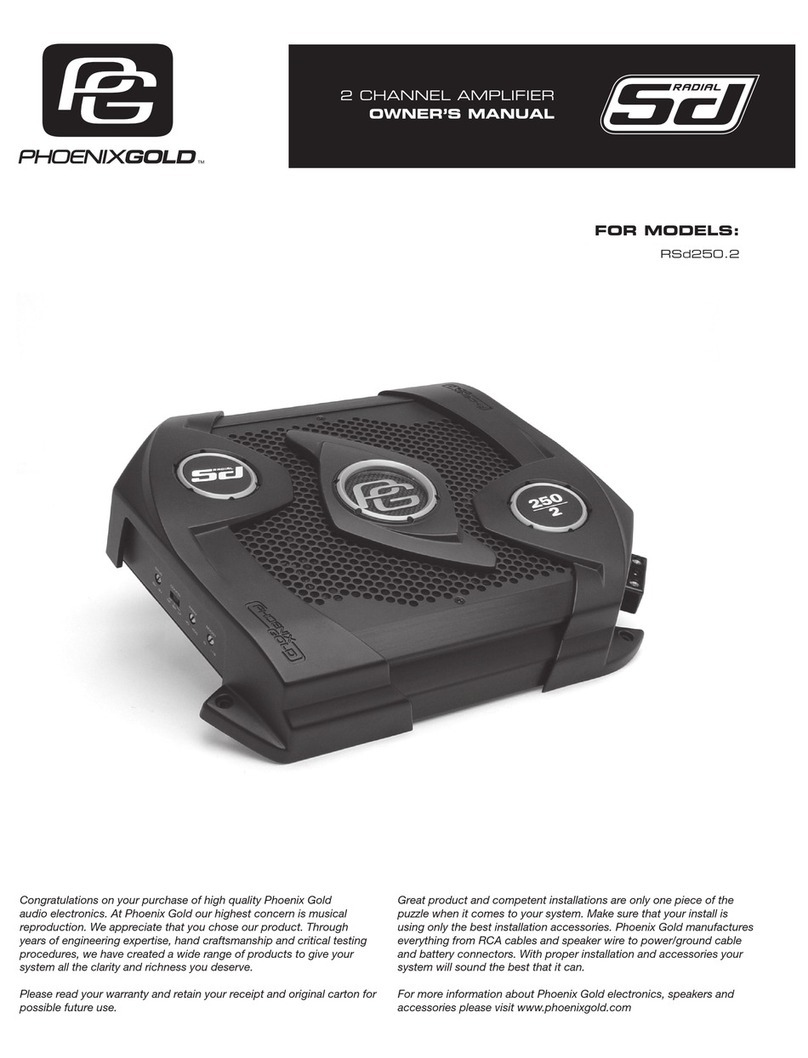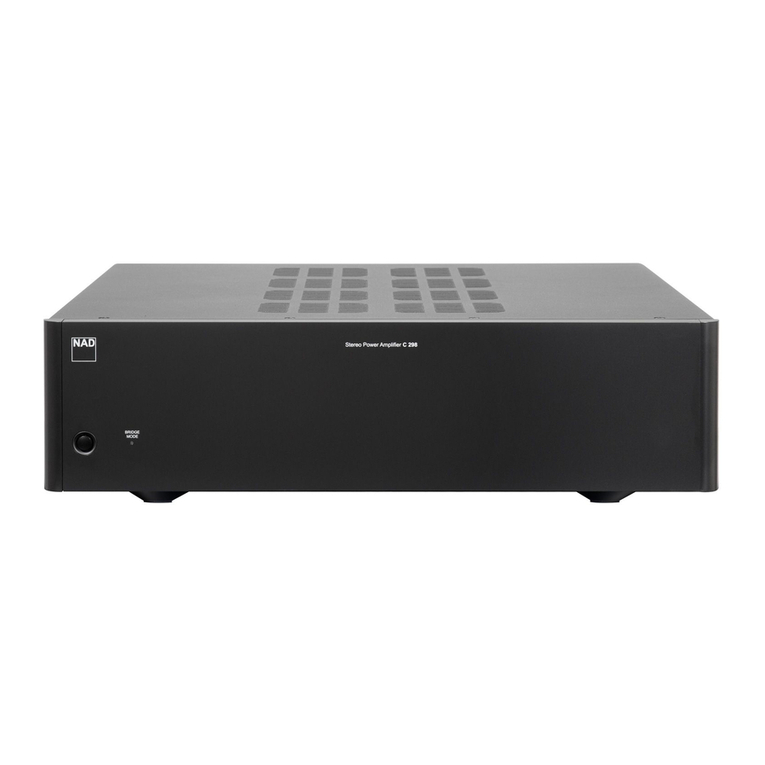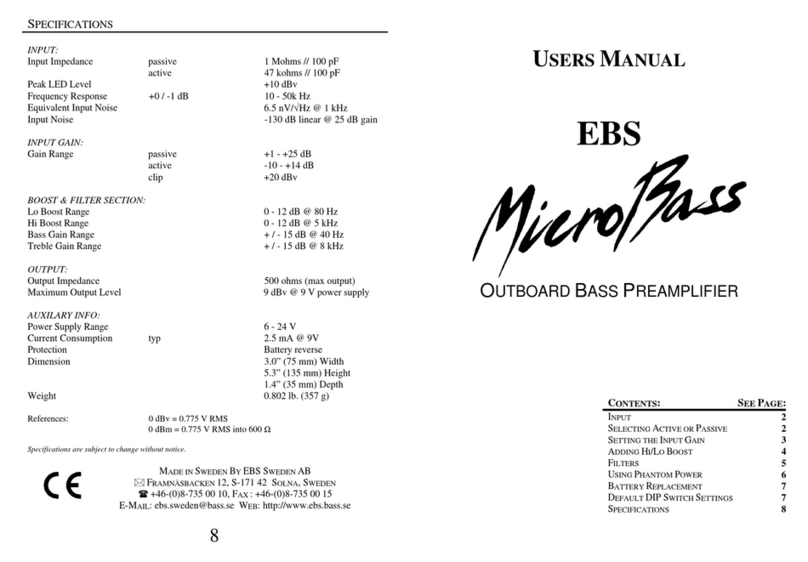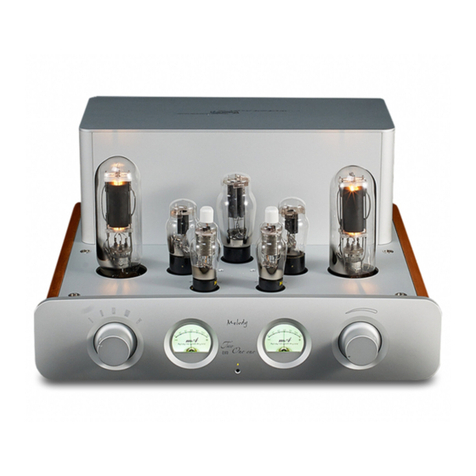Emtron DX-1d User manual

OPERATING MANUAL
EMTRON DX-1d
HF LINEAR AMPLIFIER
April 2003
Emtron
DIVISION OF EMONA ELECTRONICS PTY. LTD.
92-94 Wentworth Avenue, Sydney 2010, Australia
Tel. +612 92110988 Fax +612 92811508
www.emtron.com.au

2
DX-1d, Serial No…………
INITIAL SETTINGS FOR PLATE AND LOAD
CAPACITORS
TEST
FREQUENCY
BAND FACTORY SETTINGS
50 OHM LOAD
USER SETTING
ANTENNA
PLATE LOAD PLATE LOAD
28.600 MHz 10m
24.900 MHz 12m
21.200 MHz 15m
18.100 MHz 17m
14.200 MHz 20m
7.070 MHz 40m
3.600 MHz 80m
1.800MHz 160m
1.850 MHz 160m
1.900 MHz 160m
TABLE 1

3
TABLE OF CONTENTS
1GENERAL DESCRIPTION.........................................................................................................................................................5
1.1 DX-1D –INTERNAL VIEW ........................................................................................................................................................6
2TECHNICAL SPECIFICATIONS..............................................................................................................................................7
3UNPACKING .................................................................................................................................................................................8
3.1 OPENING THE CARTON..............................................................................................................................................................8
3.2 OPENING THE DX-1D COVER....................................................................................................................................................8
3.3 REMOVING THE PACKING BLOCK..............................................................................................................................................8
4INSTALLATION ENVIRONMENT...........................................................................................................................................9
4.1 REQUIRED ENVIRONMENT ........................................................................................................................................................9
4.2 POWER REQUIREMENTS ............................................................................................................................................................9
5REAR PANEL................................................................................................................................................................................9
5.1 POWER /EARTH CONNECTIONS ................................................................................................................................................9
5.2 RF CONNECTIONS .....................................................................................................................................................................9
5.3 TRANSCEIVER CONTROL ...........................................................................................................................................................9
6FRONT PANEL ...........................................................................................................................................................................10
6.1 CONTROLS ..............................................................................................................................................................................10
6.2 DISPLAYS................................................................................................................................................................................10
7ELECTRICAL CONNECTIONS ..............................................................................................................................................12
7.1 CONNECTIONS TO TRANSCEIVER /EXCITER...........................................................................................................................12
7.2 EARTH AND MAINS CONNECTIONS..........................................................................................................................................12
7.3 THE POWER CABLE (EXPORT VERSION) ..................................................................................................................................12
7.4 OPERATION AT 230V, 220V, 200V, 100V AND 120V (EXPORT VERSION).............................................................................12
8DX-1D DESCRIPTION...............................................................................................................................................................14
8.1 RF SECTION ............................................................................................................................................................................14
8.2 MAINS TRANSFORMER ............................................................................................................................................................14
8.3 H. V. POWER SUPPLY .............................................................................................................................................................14
8.4 SOFT START MODULE..............................................................................................................................................................14
8.5 SENSOR MODULE ....................................................................................................................................................................14
8.6 ANTENNA RELAY /QSK MODULE ..........................................................................................................................................14
8.7 DISPLAY BOARD .....................................................................................................................................................................15
8.8 CONTROLLER BOARD..............................................................................................................................................................15
9POWERING UP...........................................................................................................................................................................16
10 OPERATION ...........................................................................................................................................................................16
10.1 TUNNING PROCEDURE ....................................................................................................................................................16
10.1.1 General...........................................................................................................................................................................16
10.1.2 Preliminary tuning.........................................................................................................................................................16
10.1.3 Final tuning....................................................................................................................................................................17
10.1.4. Potential problems during tuning......................................................................................................................................18
10.2 ALC ADJUSTMENT ............................................................................................................................................................18
10.3 USING YOUR DX-1D...........................................................................................................................................................19
10.3.1 CW / RTTY and all digital modes..................................................................................................................................19
10.3.2 Voice modes (SSB).........................................................................................................................................................19
10.3.3 Hints on good linearity and efficiency ..........................................................................................................................19
11 SWITCHING THE POWER OFF.........................................................................................................................................20
12 TROUBLESHOOTING - IF SOMETHING GOES WRONG ..........................................................................................20
12.1 NO POWER ..............................................................................................................................................................................20
12.2 FAN NOT WORKING .................................................................................................................................................................20
12.3 IF THE FAULT LIGHT TURNS ON ............................................................................................................................................20

4
12.4 OVER-TEMPERATURE CUT-OFF ...............................................................................................................................................20
12.5 OVER-CURRENT CUT-OFF .......................................................................................................................................................21
12.6 IG2BLINKS FAST -NO PLATE VOLTAGE..................................................................................................................................21
12.7 SPARKS /DISCHARGES IN RF AREA ........................................................................................................................................21
12.8 SWR CUT-OFF.........................................................................................................................................................................21
12.9 FREQUENT OVER-DRIVE PROTECTION CUT-OFF ......................................................................................................................21
12.10 TUBE REPLACEMENT ..........................................................................................................................................................21
13 WARRANTY / SERVICE ......................................................................................................................................................21
14 GLOSSARY..............................................................................................................................................................................22
15 APPENDIX 1: SCHEMATIC DIAGRAMS .........................................................................................................................23
15.1 DX-1D BLOCK DIAGRAM .......................................................................................................................................................23
15.2 CIRCUIT DIAGRAM –HIGH VOLTAGE POWER SUPPLY.................................................................................................24
15.3 CONTROL BOARD AND ADJUSTMENT POINTS ........................................................................................................................25
15.4 CIRCUIT DIAGRAM –AC INPUT AND WIRING DIAGRAM –STANDARD........................................................................26
15.5 CIRCUIT DIAGRAM –AC INPUT AND WIRING DIAGRAM –U.S. VERSION ...................................................................27
15.6 CIRCUIT DIAGRAM –SOFT START (200 TO 240 VOPERATION)....................................................................................28
15.7 CIRCUIT DIAGRAM –QSK......................................................................................................................................................29
15.8 CIRCUIT DIAGRAM –RF MODULE.......................................................................................................................................30
15.9 CIRCUIT DIAGRAM –CONTROL BOARD............................................................................................................................31
15.10 CONTROL BOARD –COMPONENT LEGEND (SILKSCREEN TOP)...................................................................................32
CONTROL BOARD –SOLDER SIDE TRACK WORK ...............................................................................................................................33
16 APPENDIX 2: WAVEFORMS ..............................................................................................................................................34
16.1 QSK (OPTIONAL MODULE)SWITCHING .................................................................................................................................34
16.2 LINEARITY ..............................................................................................................................................................................34
17 APPENDIX 3: ADJUSTMENTS ...........................................................................................................................................35
17.1 CONTROL BOARD..............................................................................................................................................................35
17.1.1 PRE-BIAS ADJUSTMENT (Adjustment: POT7, marked PRE_BIAS) .........................................................................35
17.1.2 BIAS ADJUSTMENT (Adjustment: POT3, marked BIAS) ...........................................................................................35
17.1.3 SWR Protection adjustment...........................................................................................................................................36
17.1.4 EBS ADJUSTMENT (Adjustment: POT4, marked EBS). .............................................................................................36
17.1.5 SCREEN VOLTAGE ADJUSTMENT (Adjustment: POT2, marked SCREEN)............................................................36
17.1.6 SCREEN CURRENT LIMIT ADJUSTMENT (Adjustment: POT1, IG2LIMIT)..........................................................37
17.1.7 IPTRIP ADJUSTMENT (Adjustment: POT6, marking: IP TRIP)................................................................................37
17.2 DISPLAY BOARD ADJUSTMENTS ..................................................................................................................................39
17.2.1 PLATE CURRENT (Adjustment: VR4, Marked: AMP) ................................................................................................39
17.2.2 PLATE VOLTATE (Adjustment: VR2, marked: VOLT)................................................................................................39
17.2.3 REFLECTED POWER (Adjustment: VR3, marked: RF R) ..........................................................................................39
17.2.4 FORWARD POWER (Adjustment: VR1, marked: RF F) .............................................................................................39
17.2.5 SCREEN CURRENT (Adjustment: VR6, marked IG2+, VR5, marked IG2-) ..............................................................39
17.3 RF SENSOR ADJUSTMENT ...............................................................................................................................................40

5
DX-1d LINEAR AMPLIFIER
Serial No …………
OPERATING MANUAL
April 2003
CAUTION
1 GENERAL DESCRIPTION
The Emtron DX-1d Linear Amplifier is a 750 watt average output power, for the 160m through 10m amateur bands (9 bands),
housed in a desk-top cabinet with self-contained power supply and cooling system.
It utilises a single high performance tetrode, type GU74B (4CX800A),a ceramic metal tube with a plate dissipation of 800W. The
tube is air cooled by a commercial grade forced air turbine blower system.
Tetrodes offer exceptionally stable operation and levels of quality performance far exceeding that which can be expected from
triodes. The harmonic output and intermodulation distortion achieved with this tube are exceptionally low. This is especially
important when dealing with a high output power.
The Emtron DX-1d is supplied as standard with a host of features including mixed analogue and solid state metering,
comprehensive protection systems and indefinite duty cycle (continuous commercial service).
In addition, a unique Emtron QSK module is available as an option. With this installed, extremely rapid switching times between
transmit and receive are possible, with consequent advantages when using CW or the digital modes.
Operation of the DX-1d is greatly simplified by a minimum of meter switching, and the absence of front panel level setting
controls. The front panel moving LED display systems indicate the screen grid current (positive and negative), while 5 single
LED’s indicate: Ready, Overdrive warning, High SWR cut-off indication, On Air and Fault. An analogue panel meter shows the
plate current, and the second analogue panel meter measures the plate voltage, the output power or the reflected power, depending
on the position of the switch marked “Meter”. In normal operation this switch is left in Po position, which means that all the
important operational parameters are simultaneously displayed, with no need for switching meters.
The Emtron Electronic Bias Switch (EBS) automatically switches the standing current (typically 0.3 A) off when there is no
modulation. This reduces the average tube dissipation.
On initial switch on, the unique Emtron "soft start" circuitry ensures that no damaging AC surge currents are generated.
Professional, fine output tuning adjustment is possible, due to the 6: 1 reduction mechanism fitted.
The DX-1d has been designed for 100% safe operation and long life.
Interlocking sensing circuitry constantly monitors conditions inside the
amplifier. It must be noted however, that the high voltages present inside
the DX-1d are EXTREMELY DANGEROUS. Do not remove the top cover
under any circumstances if any leads are still plugged into the rear of the
amplifier - especially if the AC lead is plugged in the power outlet. Before
any component inside the high voltage, power supply or output section is
touched, unplug all rear panel leads and allow at least 5 minutes of 'off
time'. After that, you should further check this by momentarily shorting the
tube anode to the chassis with a suitable insulated lead.

6
1.1 DX-1d – Internal View
The main components of a DX-1d amplifier are shown in the picture below.
BAND
SELECTOR
PLATE
TUNING LOAD
TUNING
POWER
ON / OFF
STANDBY /
OPERATE
SWITCH
DISPLAY
TANK COIL,
40 -160 m
TANK COIL,
10-30 m
BAND
SWITCH
Temperature Sensor
RF CHOKE
RF SENSOR ANT. RELAY
BLOWER
SOFT START
SAFETY
MI
CO
R
S
WIT
C
H
HIGH VOLTAGE
POWER SUPPLY
CONTROL
BOARD
Tetrode GU84B
(4CX800)

7
2 TECHNICAL SPECIFICATIONS
FREQUENCY COVERAGE: Complete (manually tuned) coverage of the nine HF amateur bands:
1.800 – 1.900 MHz
3.500 – 4.000 MHz
7.000 – 7.500 MHz
14.000 – 14.350 MHz
18.000 – 18.500 MHz
21.000 – 21.500 MHz
24.000 – 24.500 MHz
28.500 – 29.990 MHz
TRANSMITTING MODES: Both continuous and low duty cycle modes are supported. That is, the DX-1d
supports SSB, CW, AM, FM, RTTY and SSTV. II
OUTPUT POWER: Typical 750 watts carrier or up to 1000 W PEP
DRIVE POWER: Nominal 40-60 watts for full rated output.
INPUT IMPEDANCE: Nominal 50 ohm passive impedance, unbalanced. VSWR 1.4:1 or less.
OUTPUT IMPEDANCE: Nominal 50 ohm passive impedance, unbalanced. VSWR 2.6:1 or less.
DISTORTION: Third order intermodulation products are more than 35 dB below rated output.
HARMONICS: Harmonic output is better than 50dB below the rated output.
FAULT PROTECTION: The comprehensive fault protection systems include circuitry to monitor:
•plate current: should the plate current exceed a safe value, the amplifier goes to standby mode for 2
minutes.
•screen grid over-current: Absolute tube protection is offered with visual warning and a reduced power
level being enabled if the screen current exceeds a pre-set limit.
•temperature: Should the tube's temperature exceed a specific level, amplifier operation is suspended
until the temperature drops to a safe level.
OPERATIONAL PROTECTION
•Overdrive protection: Should the DX-1d be overdriven, a LED warning indictor will light up when the
linearity limit is reached. If the drive is increased further, a 2 second cut off (by-pass) will follow.
•SWR protection: Should the DX-1d sense an SWR exceeding 2.6:1, a LED warning indicator will
light up, simultaneously with a 3 second cut off.
METERING: The front panel moving LED display systems indicate:
“Moving light” LED indicators:
•output power
•reflected power
•screen grid current
•plate voltage
•plate current
Five single LED’s:

8
•on air
•ready
•fault
•overdrive warning
•SWR cut-off indicator
ALC: Negative going, adjustable output level.
EBS: Electronic Bias Switch - automatically switches the standing current (about 0.3 A) to a lower ("pre-
bias") value - when there is no input drive.
PRE-BIAS: A small current will flow in the tube when the amplifier is keyed on, but there is no modulation.
This will prevent a harsh sound at the beginning of each word, when the EBS is activated and the tube goes
through a non-linear zone, before reaching the correct initial bias.
QSK: is an option that makes possible the antenna switching at very fast rate - typically 3ms switching time
in each direction. FACTORY INSTALLED ONLY.
SOFT START: when switched on, the mains power is gradually applied to the transformer, over a period of
about 5 seconds, to avoid the high in-rush current typical for such high loads.
COOLING: forced air cooling.
OPERATING TEMPERATURE: 0 to 40° Celsius
FUSING: Two 15A normal acting fuses on the rear panel
DIMENSIONS: 380mm wide, 180mm high, 380mm deep
WEIGHT: 20kg (44 lb) unpacked
3 UNPACKING
The DX-1d is packed in a heavy duty package easily sufficient to protect the amplifier during transportation,
even in case of fairly rough handling. The weight of the commercially rated mains transformer does mean,
however, that dropping the amplifier would without doubt result in some damage.
3.1 Opening the carton
When opening the packing, do not cut the carton. Save the packing material for possible further re-use.
Shipment of your DX-1d in other than factory packing may result in non-warranty damage.
3.2 Opening the DX-1d cover
An inspection of the interior of the amplifier should reveal no damage or adversely affected components.
Remove the 4 screws on each side and remove the cover. Should there be any form of problem, notify your
supplier immediately.
3.3 Removing the packing block
Assuming all is well, remove the block of foam from the amplifier bay and check that the amplifier tube is
firmly pressed home. Make sure the temperature sensor above the tube is in horizontal position or
slightly up position. If the sensor is bent down and touches the tube or if comes too close to the tube, the
plate high voltage will be shorted and damage could occur. Replace the cover and secure all four screws that
hold the cover in place.

9
4 INSTALLATION ENVIRONMENT
4.1 Required environment
The DX-1d amplifier can be operated at an ambient temperature between 0 and 40° Celsius. It should be
installed in a place with good ventilation and protected from the direct sunlight. At least 5 cm of free space
must be left at the left and right of the amplifier for ventilation. Do not place any object on top of the
amplifier, especially above the ventilation opening.
An environment free of dust, smoke and high humidity is required, as for any high powered RF amplifier.
Dust or particles resulting from burning fire wood or coal could be responsible for sparks or electrical
discharges between the capacitor plates, or in other parts of the RF section.
4.2 Power requirements
When operating at full power, up to 9A from the 240 VAC mains is required. Ensure that the AC supply you
intend to use is fully rated and properly fused. The Emtron "soft start" circuitry ensures that there are no
momentary surges of current at power-up, therefore the fuse does not need to be over-rated. However, the
wiring of the mains supply for the amplifier should be able to handle the power at full load with minimal drop
in the voltage, to insure the performance of your DX-1d does not suffer.
5 REAR PANEL
The following connectors and controls are present on the rear panel
5.1 Power / Earth connections
A wing-nut Earth connection is provided at the rear of DX-1d. A good Earth link must be provided here.
Connect this first, before making any other connection to the amplifier. Two fuse holders are fitted along with
15A, normal acting fuses.
5.2 RF connections
RF INPUT
The RF input is an SO-239 female connector. A 50 ohm coaxial cable line of good quality terminated with a
PL-259 coaxial connector is required to connect the transceiver or exciter output to the input connector of
your DX-1d amplifier.
RF OUTPUT
The RF output is also a female SO-239 connector. The use of a high quality RG-8A/U, RG-213 or similar 50
ohm coaxial cable line terminated with a ‘VHF’ type PL-259 connector is essential. Similarly, a VSWR of
2.6: 1 or better is mandatory. Remember too, that the EMTRON DX-1d amplifier can deliver 750 W
continuously and up to 1 kW PEP in the SSB mode. Not all antennas can handle such power.
5.3 Transceiver control
ALC
The ALC output is via a black female RCA connector.
This is an ALC system for use with transceivers or transmitters having a negative-going ALC system and
possessing an external ALC input jack. A shielded patch lead with an appropriate connector at one end and a
male RCA connector for the DX-1d at the other end is required. Check the specifications of your transceiver
for a suitable connection.
PTT

10
The PTT input is a female RCA connector (red). This line controls the transmit / receive switching system.
This jack must be connected to transceiver or exciter relay contacts which are open on RECEIVE and closed
on TRANSMIT. In the standard version (DX-1d fitted with a l2V antenna relay), the PTT input presents an
open circuit voltage of + l2V with respect to the chassis, with an impedance of about 70 ohm. Therefore, a
current of typically 0.17 A must be switched by the transceiver or exciter.
In the QSK version, the voltage at the PTT input is typically 28V loaded (up to 35V unloaded), with an
impedance of about 240 ohm. A current of about 0.12 A has to be switched in this case.
ALC CONTROL
This is a user-accessible control for setting the negative voltage at the ALC output. Further details are given
in section 10.2
6FRONT PANEL
The following controls and indicators are present on the front panel:
6.1 Controls
BAND SWITCH
A nine position switch selects the desired frequency range. The operating bands are indicated in metres.
PLATE TUNE
Tunes the amplifier operating frequency. A chart of approximate starting settings is given in Table-1
LOAD TUNE
Tunes the amplifier output loading. A chart of approximate starting settings is given in Table-1
ON/OFF
Switches the AC power on and off. On initial switch on, the standby mode is enabled. Note also the
appropriate switch down sequence, given in Section 11.
OPR/STBY
Enables the amplifier once it has warmed up. In STANDBY mode, the screen voltage is removed and any RF
power applied to the input, is bypassed to the output. If this switch is changed to OPERATE before the
READY light comes on, the FAULT light will turn on. This is not a fault, but it is better to leave the switch in
STBY position until the amplifier is ready to operate.
6.2 Displays
Output Power - Scale up to 1 kW, non linear.
Reflected Power - Scale up to 150W, non linear.
Plate Voltage - Scale up to 3kV
Ig2 - Zero-centred display. The left (green) side has a full scale of about 25 mA of negative screen current.
The right (red) side has a full scale of about 35 mA of positive screen current. Above this value, the red LEDs
will flash, warning you to increase the loading, or reduce the drive. At about 40 mA, the protective current
limiting will cut in.
Plate Current - Scale up to 1.5A.
ON Air - single LED, green. When pressing PTT, this LED turns on (while in OPERATE)

11
READY - single LED, yellow. Turns on at the end of warm-up period, when the mains power to DX-1d is
switched on. It turns off for about 2 minutes if the plate current protection is triggered. In this case, the
FAULT light also turns on.
FAULT - single LED, red. Turns on in 3 situations:
•when the over-temperature protection is triggered, the FAULT turns on until the tube cools to a safe
level. During this time, the operation of the amplifier is disabled, the screen voltage is off and any RF
power applied to the input is bypassed directly to the output.
•when the over-current protection is triggered, FAULT turns on for 2 minutes, while READY turns off
•at DX-1d power up, if the OPR/STBY switch on the front panel is left in OPR position. The FAULT
light will go off when the DX-1d is ready for operation, after warm-up.
SWR - single LED, red. A three second cut-off will happen if your antenna has a SWR worse than 2:1
(typical 2.6:1) at the operating frequency. During the cut-off, the RF from the input is directly by-passed to
the output.
OVER-DRIVE - single LED, yellow. Flashes when the input drive is exceeding the linear operation level. If
even more drive is applied, the overdrive protection will cut off the operation for about 2 seconds.
NOTE: the input drive at which the indicator turns on depends on a certain extent on the tuning of the
amplifier.
Figure 1. Front Panel Display
RF OUTPUT POWER
(
kW
)
REFLECTED POWER (W)
PLATE VOLTAGE
(
kV
)
PLATE CURRENT
(
A
)
I
g
2
OVER
DRIVE
ON AIR
READY
SWR
FAULT

12
7 ELECTRICAL CONNECTIONS
7.1 Connections to Transceiver / Exciter
Signal connections
Before making any connections, ensure that DX-1d is not connected to AC power, and the transceiver is not
transmitting. Connect the antenna first to the DX-1d output. Then connect the transceiver output to the DX-1d
RF input. Plug the PTT lead into the RCA socket marked PTT on the rear panel. If required, connect the
ALC.
The most appropriate interconnection layout is shown in Figure 1 below. In this set-up, the transmit/receive
relays in the DX-1d are controlled directly by the transceiver or exciter.
Figure 2. Connections between DX-1d and Station Transceiver
7.2 Earth and mains connections
Power connections
Before connecting any power to the amplifier, make a good Earth connection to the screw with wing nut at
the rear of DX-1d. Make sure the POWER switch on the front panel is in the OFF position. Then plug the
power cable into the power point.
7.3 The power cable (export version)
As different countries have different standards for their power connections, the DX-1d amplifiers exported
from Australia are supplied without power cables. A power cable with IEC termination on one end and the
local type of plug needs to be fitted.
7.4 Operation at 230V, 220V, 200V, 100V and 120V (export version)
The Emtron DX-1d will normally arrive pre-set for the power source of the country the amplifier has been
sold to. However if operation to another mains voltage is required, the appropriate connection changes will be
needed.
Figure 2 shows the transformer connections for 120V, 200V, 220V, 230V and 240V operation. If a change is
required, this should be done only by a qualified technician, after taking all the necessary safety precautions.
See CAUTION on page 1.
PLEASE NOTE: For 120V operation, the fuse rating is 20A. Also, the QSK module needs a
modification, the DX-1db should be ordered for 120V operation.
EMTRON
DX-1d Station
Transceiver
PTT
Relay
Input ALC
PTT
Relay
Output
ALC
(
O
p
tional
)
RF
OUT
RF
IN
RF
OUT
TO ANTENNA

13
Figure 3: TRANSFORMER AC INPUT CONNECTIONS
0
100120
0
110 100120
0
100120
0
110 100120
0
100120
0
110 100120
LINK
LINK
0
240
LINK
230
220
0
0
240V:
230V:
220V:
0
100120
0
110 100120
0
100120
0
110 100120
LINK
0
0
200V:
120V:
200
120
FAN
FAN
FAN
FAN
FAN
0
100120
0
110 100120
100V:
0
100
FAN

14
8DX-1d DESCRIPTION
8.1 RF Section
The RF section occupies the right hand side of the DX-1d (looking from the top - front). See picture in 1.1.
RF Switch and tuned circuits
At the front of the amplifier are two variable capacitors, for plate and load tuning. A 9-position ceramic
switch is employed for the 9 operating bands. Next to the switch is the 40 to 160 metre tank coil. The silver
plated, large diameter copper tube is the 10 to 30 metre tank coil.
RF Sub-chassis
The 4CX800A tube is positioned on a separate RF sub-chassis. All the connections to the tube, except for the
plate, are under this sub-chassis. A 9-way heavy duty connector is used for the outside connections. The fan
blows air into this sub-chassis, which is forced out through the ventilation fins of the tube. The air
temperature is sensed by a sensor placed above the tube. The sensor must stay in a position close to
horizontal. Make sure you are not pushing it down, too close to the tube, as high voltage exists between them.
The plate is connected to the RF network and to the choke supplying the 2100VDC voltage to the plate of the
4CX800A tube.
8.2 Mains transformer
The transformer is the heart of the amplifier, a high performance type, designed to reduce the size and weight.
It is built with a generous reserve of power, handling easily the DX-1d requirements in continuous operation.
The primary can be wired for 120V, 200VAC, 220VAC, 230VAC or 240VAC operation. See Figure 2. There
are several secondary windings, as follows:
•Filament supply
•Low voltage supply to the controller board
•QSK module supply
•Bias supply
•Screen grid supply
•High voltage supply
8.3 H. V. Power Supply
A full wave bridge rectifier and filter converts the high voltage AC into high voltage DC with a huge reserve
capacity of 58 microfarads.
8.4 Soft start module
At power up, the mains power is gradually applied to the transformer by the soft start module. The power is
gradually applied over a time of about 5 seconds, avoiding the high inrush current typical for such big loads.
8.5 Sensor module
A small metal box positioned at the output of the DX-1d. It detects the forward and reverse power, for
measurement and display.
8.6 Antenna relay / QSK module
In the standard DX-1d, the antenna relay is controlled by the transceiver, via the control board. It switches the
antenna between the transceiver, during reception, and amplifier, during transmission. It is also used to bypass

15
the RF from the transceiver, directly into the antenna, when the amplifier is in standby mode, or during
special conditions like overdrive, bad SWR or other error conditions.
When the QSK option is installed, this is a module with two very fast, high power vacuum relays, and the
control circuitry. The purpose of QSK is to allow very fast switching between transmit and receive, during
digital communications. See Annex 1 showing oscilloscope displays of fast switching times and contact
bounce-free operation of the QSK module.
8.7 Display board
This board has a number of inputs where various voltages are connected. The board converts these voltages
into a "moving LED" type of display. Two of these displays have flashing light indication (Ig2 and plate
current).
8.8 Controller board
The brain of the amplifier is the Controller Board. The following circuitry is part of this board:
•Bias voltage regulator, also incorporating a sensitive grid current detector for overdrive detection .
Adjustable pre-bias, removes the distortion at the beginning of the word, when EBS is activated.
•Screen voltage regulator, with adjustable voltage and adjustable current limiting, for tube protection.
•Overdrive protection and timer - based on detecting grid current, it initially gives visual warning and,
at higher level of overdrive, it cuts off the amplifier for 2 seconds. It ensures a clean signal, making
it virtually impossible to overdrive the DX-1d
•SWR detector and timer - switches the amplifier to bypass mode for about 3 seconds when high SWR
is detected. Adjustable SWR level. Factory adjusted to about 2.6: 1
•EBS - the Electronic Bias Switch - senses the presence of RF input power and turns on the bias to start
transmission. Factory adjusted for about 0.5W. When the input power exceeds this limit, the plate
current starts flowing. When there is no speech, even for a very short time, the tube dissipation is cut
to a low value, as set by the pre-bias adjustment.
•Interlocking, timer for filament warm-up
•Relay control: ready relay, SWR relay, over-drive relay, antenna relay
•QSK switching control
•Display control: Ig2 measurement and display, SWR cut-off display, overdrive warning display,
READY display, FAULT display
•Logic circuitry, low voltage supply to the various electronic circuits

16
9 POWERING UP
Before switching the power on, check all the necessary connections: Earth, Antenna, Transceiver, PTT, ALC.
Make sure the 2 switches on the front panel are in the positions: OFF, STBY.
Switch now the mains power ON (The power switch to ON position). The "soft start" system will take about 5
seconds to fully turn the power on. SWR light will turn on briefly, then off. Wait for the DX-1d to warm up,
until the READY light turns on.
This takes about 2 - 3 minutes.
WARNING !
WHEN YOU SWITCH THE POWER ON, YOU MUST HEAR AIR FLOW NOISE.
IF THERE IS NO AIR FLOW NOISE, SWITCH THE POWEROFF IMMEDIATELY
AND CONWACT YOUR SUPPLIER.
10 OPERATION
10.1TUNNING PROCEDURE
10.1.1 General
For each band and operating frequency, the transceiver settings must match the position of the BAND switch on
the front panel of the DX-1d, while the PLATE and LOAD knobs must be adjusted for optimum operation
which gives – in conjunction with the input drive level, the maximum output power that can be obtained for that
input power. When the tuning is correct, this will also result in a minimum plate current, minimum plate
dissipation and good linearity.
10.1.2 Preliminary tuning
•Turn the BAND switch to the same band setting as the transceiver.
•Put LOAD and PLATE knobs in the initial positions given in Table 1.
•DX-1d must be powered ON and "Ready", with the OPR/STBY switch in OPR position.
•Start with the transmitter at minimum power, in a "carrier" mode e.g. RTTY of CW - key down.
•Key the transceiver ON and gradually apply power to the DX-1d. When 0.5 to l W of drive is reached,
the EBS is activated and the plate current jumps from zero to about 0.3 A
•Increase the drive until there is some output power indicated. If the current plate Ip reaches about 0.5 A
and there is still no output indication, turn PTT off and check the connections, the band and the initial
settings.
•As soon as there is any power indication, tune PLATE for maximum output (and minimum plate
current).
•Apply more drive and adjust PLATE again for maximum output. Keep PTT ON for short time only
(about 10 seconds). Go gradually, in several steps. When about 4 - 500W output is reached, adjust
LOAD for maximum output. If there is no red Ig2 indication, it is likely that LOAD needs to be turned
clockwise, towards higher numbers on the dial.
•Apply more drive and adjust both knobs again. When screen current appears (red Ig2 indication),
increase loading by turning anti-clockwise the loading knob. (LOAD towards lower numbers on dial)
until Ig2 drops almost to zero. Then adjust PLATE for maximum output power and maximum Ig2. At
this point, Ig2 is the most sensitive indicator of resonance on the working frequency. If Ig2 goes too high
(e.g. starts blinking), increase the loading again, then tune PLATE.

17
•Repeat the above steps, while gradually increasing the input drive power, until the overdrive indicator
just starts turning on. Now the DX-1d is tuned for operation at full power on that particular operating
frequency.
NOTES:
1. The maximum power is obtained from a DX-1d when:
onset of the overdrive indication
PLATE is tuned for maximum output power, maximum screen current Ig2 and minimum plate current, Ip
Ig2 indicator shows 2 or 3 red LEDs.
2. The above conditions will also give the best linearity.
3. During the preliminary tuning, switch PTT on and off several times, to allow time for tube cooling. The tube
dissipation (at a given drive level) is minimum when tuning is optimum. In short, be brief, with tuning "bursts".
4. Preliminary tuning, as described above, is only necessary when operating for the first time in a certain band.
When the final settings for PLATE and LOAD have been found for the particular working conditions -
especially the antenna used, note your settings on Table 1. The new settings will normally differ to some extent
from the ones indicated, depending on the "purity" of your antenna load.
10.1.3 Final tuning
Once the preliminary tuning has been done for each band / antenna combination, the values found for PLATE
and LOAD can be used for final tuning, with no need to repeat the preliminary tuning every time.
Tuning for full power
•Start with low drive level and the PLATE and LOAD knobs in the known initial positions
•Put PTT ON and increase the power (fairly quickly), to the onset of the overdrive indication. If the
screen current (red Ig2) goes too high, adjust LOAD, by turning the knob to the left (increasing the
load).
•Adjust the drive level and LOAD until the overdrive indicator is just about to turn ON, and at the same
time Ig2 shows two or three red LED's ON.
•Fine tune PLATE for maximum output and maximum Ig2. Repeat the step above if required.
Tuning for less than full power
•Start at low power, with the initial values for PLATE and LOAD
•Put PTT ON and apply drive until the output is about 1/2 of the desired power.
•Adjust LOAD for maximum output. Most likely, the knob will have to be rotated to the right, towards
higher numbers on the dial.
•Adjust PLATE for maximum output
•Apply more power
•Repeat the 3 steps above until the required power is achieved. If screen current is indicated by Ig2, is
should, display one to three red LED's. Maximise this Ig2 indication (and the output power at the same
time), by tuning PLA TE
Please note that the tuning at lower power is different from the setting at full power.
•If the output goes higher then desired, reduce the drive and re-tune. Never reduce the output by de-
tuning the amplifier!

18
NOTE: If the output is low (say, less than about 400W), Ig2 will never show any screen current at all. Ig2 might
even indicate a negative current, in green - this is normal and is no cause for concern).
However, if there (green) negative current indication, usually this will go away with better tuning of the PLATE
control.
If there is no Ig2 red indication., simply rotate LOAD to the right in small steps, and each time maximise the
output by turning PLATE, until the highest possible maximum in the output power is achieved.
10.1.4. Potential problems during tuning
The tuning operation. should be completed fairly quickly. If the tuning process takes a longer time, it should be
done by switching the transmission on and off several times, to allow the tube time to cool.
•If the FAULT light comes on, it is possible that the plate current has reached too high values due to
incorrect plate tuning. In this case, reduce the excitation power, wait for the FAULT light to turn off
(about 2 minutes) and resume tuning.
•If the overdrive protection is activated, by cutting off the amplifier for 2 seconds. It is likely in this case
that you are applying too much power at the input. Reduce the power and watch the "overdrive" LED.
Increase the power only until this light starts flashing.
•If the overdrive protection is activate at low power – this could be due to incorrect loading. Turn the
LOAD control clockwise and tune PLATE. Increase the drive and repeat in small steps. A lack of screen
current (red Ig2 display) is an indication that the loading is incorrect.
•If the SWR protection cuts in - it is likely that your antenna is not a good 50 ohm match at the operating
frequency. In principle, the SWR protection level in DX-1d is adjustable, but it is far preferable for you
to fix your antenna.
10.2 ALC ADJUSTMENT
The DX-1d can be operated without any ALC connection. However, if you wish to use it, and your transceiver
has an ALC input, then the potentiometer on the rear panel must be adjusted. This adjustment is not critical,
since its voltage output is zero under normal operation and it increases sharply (towards a negative value - up to
-11 V), when the overdrive limit is approached. The ALC in DX-1d amplifier is not a conventional design, this
circuit operates for only one reason - to prevent overdriving and to keep the signal clean.
To adjust the ALC potentiometer:
Turn the potentiometer initially all the way to the right (minimum ALC voltage)
In CW mode, after tuning, apply increasingly higher drive, until the "overdrive" LED just starts to turn on
Increase the drive slightly more, to have the light fully on, but make sure the DX-1d overdrive protection does
not cut you off. At this power level, adjust the ALC potentiometer to the left, until the transceiver drops its
power output.
Alternatively, in voice mode, increase the RF gain or the microphone gain until the overdrive led is flashing at
peak of modulation. Then, increase ALC (rotate potentiometer to the left) until the transceiver begins to limit the
drive to DX-1d.
NOTE: Some types of transceivers (e.g. YAESU FTI00MP, FT920 and others) are not compatible with this
type of ALC. They require an ALC signal proportional with the output power. DX-1d' s ALC is zero until the
drive reaches the over-drive limit, when the negative voltage increases sharply. YAESU operating manual
indicates that this type of ALC might not work well with their transceivers, since grid current could be
generated by amplifier mis-tuning not related to excessive drive conditions. If this is the case, simply do not
connect it.

19
10.3 USING YOUR DX-1d
While tuning and adjusting the amplifier, a CW mode is normally used. When these operations are finished, you
can change to the operating mode you wish to use and start operating.
10.3.1 CW / RTTY and all digital modes
In CW, the setting up of the amplifier is similar to that of the tuning mode. After adjusting the input power level
to the amplifier, according to the desired output level, and tuning the plate and load capacitors, you can simply
start operating by applying the same carrier level as during tuning. If the amplifier is set to deliver full output
power, or close to, then screen current will be present. As in the case of tuning, the best operation is achieved
when there is a certain amount of screen current flowing, corresponding to two or three red LED's turning on in
the Ig2 display.
10.3.2 Voice modes (SSB)
When a voice modulation is applied to the amplifier, the drive level is not precisely defined, as in the case of
tuning with continuous carrier. If there is screen current flowing, or an input overdrive, they will be indicated
only at peak of modulation, by the respective indicators flashing. You will have to adjust the microphone gain,
or the RF drive, or both, in an attempt to achieve input driving conditions similar to those you have used while
tuning. Occasional flashing of the overdrive indicator is acceptable. If the over-driving is severe, a momentary
cut-off will occur.
10.3.3 Hints on good linearity and efficiency
Operating with good efficiency: If you are watching the plate current indicator, you must be aware that the total
power the amplifier is drawing from the mains is proportional to the plate current. Power that is not sent to
antenna, is dissipated by the tube. As explained in the Tuning section, the best tuning achieves a maximum
power output at the same time with a minimum plate current, drastically minimising the tube dissipation. Be
aware that at a low power level, slightly different tuning is required than is for full power.
Achieving the best linearity: The amplifier must be tuned and operated all the time in the linear mode. This is
important because a non-linear operation will generate harmonics which will disturb RF communications in
other bands and frequencies.
We must distinguish two situations:
Less than full power.
With less then full power (say 500W or less), correct tuning, no screen current and no input overdrive
indication, you will always have your DX-1d operating with a good linearity and clean signal.
Full power operation.
At full power, there are two things that must be watched to see when you reach the limit of linear operation: the
screen current, Ig2, and the grid current, indicated by the "Over-drive" LED.
In this case a good linearity is maintained up to the moment when the screen current is approaching the full
scale value of the Ig2 indicator and it starts flashing, or when the overdrive indicator fully turns on.
A high screen current, indicated by 4 LED's on in the Ig2 display, will create a moderate level of distortion.
Even a small amount of grid current will cause severe distortion. When the "Over-drive" indicator just begins to
turn on, there is a very small amount of distortion, created by a grid current of about 100 microamperes.
With this indicator flashing, you are at the limit of the RF carrier clipping. This is probably more acceptable in a
voice mode of operation. In CW or digital modes, the best is to slightly reduce the drive, just below this level. A
severe level of over-driving is not possible anyway, due to the cut-off protection. The cut-off will happen at
about 400 microamperes of grid current. See the Appendix 2 and the Troubleshooting section for oscilloscope
displays showing examples of a two tone generator driving the DX-1d in linear mode, and an overdrive
situation, when a DX-1d with the overdrive protection disabled is being overdriven by the two-tone generator.

20
The Ig2 indicator should have three to four LED's flashing on at peak of modulation. This (combined with a
correct plate tuning), indicates an optimum loading, good efficiency and good linearity. A lower screen current,
due to excessive loading, will reduce the output power, with an equal amount of extra power dissipated by the
tube. A higher screen current, making all four LED's in the Ig2 flashing, will increase the distortion.
11 SWITCHING THE POWER OFF
When you have finished using the amplifier and you want to switch it off, the following procedure is
recommended: Stop transmitting. Put the switch on STBY. Leave the DX-1d running idle for a few minutes, to
cool the tube, then switch the power off.
12 TROUBLESHOOTING - If something goes wrong
12.1 No power
When you switch on a DX-2, it takes about 3 - 5 seconds for the lights on the front panel display to come on.
This is due to the "soft start" circuit. If nothing happens after turning the power on, switch off at the front panel,
then check the following:
make sure the power point has power
make sure the power plug is fully pushed in into the power outlet and into the rear IEC connector
If it is still not working, unplug the power cord from the mains, then remove the fuses from the fuse holders on
the rear, panel of DX-1d and check them with an ohmmeter. If a fuse is blown, replace it with a fuse of the same
type and try again. If the fuse blows again, or if the fuses were not blown in the first place, contact your
supplier.
12.2 Fan not working
As soon as you switch the power on, you should notice two things about your DX-1d: the display should
indicate about 2600V of plate voltage and you should be able to hear the fan running. The amplifier is not
supposed to be powered without the fan, even in idling mode. If the fan does not operate when you power up, or
if it stops while using the amplifier, switch the mains power off immediately and contact your supplier.
12.3 If the FAULT light turns on
The FAULT (red) light turns on in two situations:
Over-current in the plate circuit
This could happen due to a flash-over in the tube, or as a result of a momentary high plate current during tuning.
This completely disables the amplifier for about 2 minutes. The same timer is activated as when the amplifier is
switched on, causing the READY light to turn off. If the middle switch on the front panel is put on STBY, the
FAULT will turn off, but the READY will be also off. When the READY comes on again, the FAULT will
disappear (if the amplifier was left in OPR), and the DX-1d is ready to operate again.
Over-temperature cut-off. See below.
12.4 Over-temperature cut-off
The operation of the amplifier is disabled, but the timer is not activated. The READY light remains on, along
with the FAULT light. When the tube cools down, the FAULT turns off and the operation can resume. This type
of fault should never happen. DX-1d has a very efficient air cooling system. When the ventilation is not
Table of contents
Other Emtron Amplifier manuals
